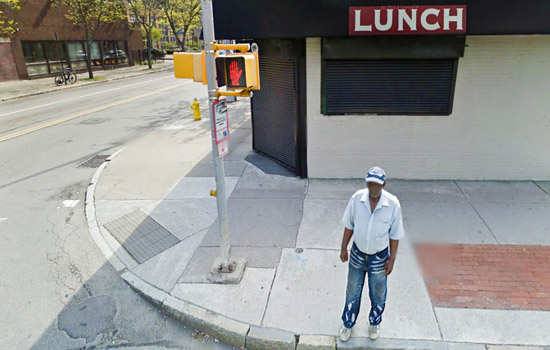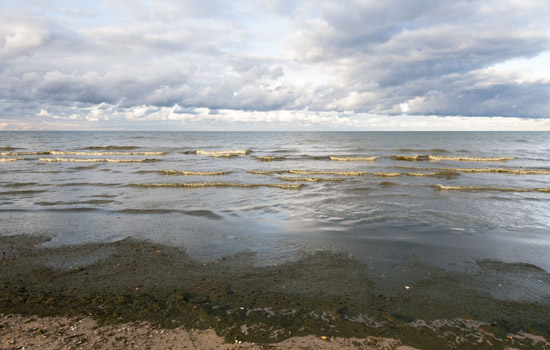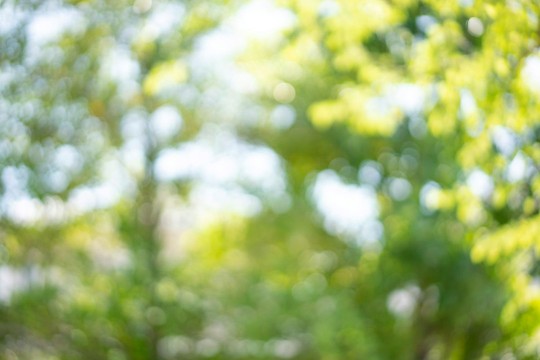Art students explore Rochester environments
Collaborative show with Alfred State College design students on display until Jan. 10
Kyleen Dziewit-Ploch
In this photograph, the dramatic lighting creates a romanticized view of Lake Ontario, but imperfections are evident in the watercolor, the sludge on the shore and the man made intrusions in the landscape. This image is part of the “Connections: Spaces, Places & the Urban Fabric” exhibition at the Rochester Regional Community Design Center.
A student exhibition—including the work of photography and industrial design students from Rochester Institute of Technology—now on display in downtown Rochester provides a fascinating exploration into human experience with urban environments.
The exhibition, titled “Connections: Spaces, Places & the Urban Fabric,” opened Dec. 6 and runs through Jan. 10 inside the Design Gallery at the Rochester Regional Community Design Center, 1115 E. Main St. (in the Hungerford Complex). In addition to RIT, the exhibit features work from Alfred State College design students.
“From Main Street to master planning, the urban environment is constantly being shaped by human activity,” said Roberley Bell, a professor in the School of Photographic Arts and Sciences at RIT’s College of Imaging Arts and Sciences. “This exhibit is a series of human interventions showcasing the innovative to the overlooked.”
In the Visualizing Place part of the exhibit, RIT photography students explore urban Rochester and “captured the overlooked beauty that lies beneath the surface,” Bell said.
“The outcome is a series of thought-provoking images that showcase the essential qualities that make up a place like Rochester,” she said.
In one image, Kyleen Dziewit-Ploch, a fourth-year fine art photography major from Milwaukee, Wis., presents a troubling view of Lake Ontario in highlighting the importance of fresh water in the region.
“The dramatic lighting creates a romanticized view of Lake Ontario, but when you look closely, you see that it’s not the postcard-perfect seascape that it may have been in the past,” Dziewit-Ploch said. “While the scene may still be beautiful, imperfections are evident in the watercolor, the sludge on the shore and the man-made intrusions in the landscape.”
In her photo titled “Still Life of Rochester,” Amanda Figliola included representative elements such as lilacs (Highland Park), produce (Rochester Public Market), a trout (Genesee River), and film canisters (Eastman Kodak Co.) to represent Rochester’s rich history.
“My inspiration for the image came from the style of many Dutch still-life paintings,” said Figliola, a third-year advertising photography major from Middletown, N.J. “The elements in the image represent specific highlights about our wonderful city.”
Nicole Rosenberg, a third-year fine art photography major from Madison, Wis., captured images taken on numerous walks through the city—with an interesting twist.
“I was drawn to the oddities of the city, the colors on the streets, and beautiful moments produced by the people and light,” said Rosenberg. “My compositions are not what they seem if you notice the small imperfections, the odd blurs, and the uneven lines because these snapshots of Rochester have been produced from a virtual walk on Google Maps.”
RIT industrial design students from Bell’s public space class are also displaying their design work in the Art in Transit portion of the exhibit. Building on the efforts of public transportation organizers across the nation to revamp their image and infrastructure, students were asked to design a public art project for the Rochester Regional Transit System. They produced a series of unique installations to enhance the everyday user’s experience that might range from temporary to permanent.
Alfred State College students, through their projects on display in the Urban Design portion of the exhibit, worked with municipal planners, citizens and design professionals to create visionary plans for the revitalization of the hamlet of Campbell in Steuben County. To create their designs, two teams of students performed a site analysis, took part in community workshops, and gained feedback on their designs from community members.
According to Bell, the idea for the student exhibition came about when she was approached after working with the Rochester Regional Community Design Center on previous exhibits. Bell later invited Laurie O’Brien, a visiting assistant professor who teaches 4D design, to have her students join in exhibiting work as well.
“This is great opportunity for RIT students to share their work about Rochester with others students and the community at large,” said Bell.
The exhibit is open from 9 a.m. to 5 p.m. Monday-Friday through Jan. 10. For information, go to the Community Design Center of Rochester website or call 585-271-0520.
 This snapshot of Rochester was produced from a virtual walk on Google Maps. This image is part of the “Connections: Spaces, Places & the Urban Fabric” exhibition at the Rochester Regional Community Design Center. Nicole Rosenberg
This snapshot of Rochester was produced from a virtual walk on Google Maps. This image is part of the “Connections: Spaces, Places & the Urban Fabric” exhibition at the Rochester Regional Community Design Center. Nicole Rosenberg The inspiration for this photo—featuring elements representative of Rochester’s history—came from the style of many Dutch still life paintings. This image is part of the “Connections: Spaces, Places & the Urban Fabric” exhibition at the Rochester Regional Community Design Center. Amanda Figliola
The inspiration for this photo—featuring elements representative of Rochester’s history—came from the style of many Dutch still life paintings. This image is part of the “Connections: Spaces, Places & the Urban Fabric” exhibition at the Rochester Regional Community Design Center. Amanda Figliola














